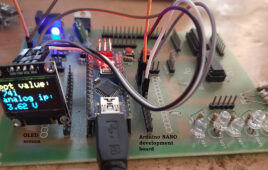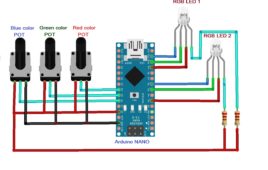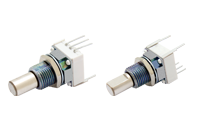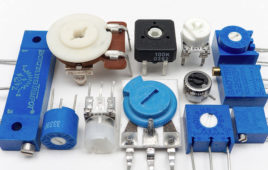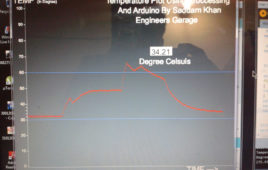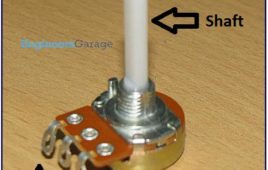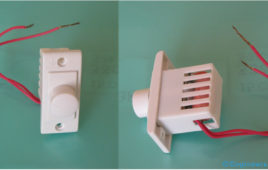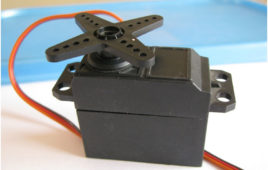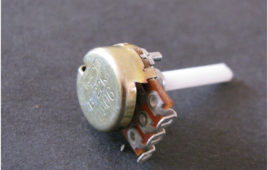In this mini do-it-yourself (DIY) electronic project, we’ll design a multi-use level indicator that can measure multiple physical parameters like temperature, water, voltage, humidity, distance, and more. It consists of a bar-graph LED display that presents the measurements. Four main types of sensors are used to measure the different physical parameters, including the following LM35…
How to program an OLED display with Arduino
Sensors are used to convert a physical quantity, such as light intensity or temperature, into an electrical one. There are several types of sensors that can easily be used with an Arduino board, which is an advantage. For example, any analog or digital sensor easily interfaces with Arduino as the board offers both analog and…
Color generation using RGB LED, Arduino, and potentiometer
RGB LED is a combination of three LEDs red-green-blue together. It has four terminals – either anode or cathode, and the other three are for these three colors. Interestingly, when two colors inside the LED are turned ON simultaneously, the LED gives a different color. Also, as the amount or intensity of any color in…
Vishay’s new panel potentiometer delivers industry-high rotational torque
Vishay Intertechnology announced a new modular panel potentiometer that delivers industry-high rotational torque of 8 Ncm — which is 200% higher than the closest competing device. It is ideal for off-road, aeronautics, and industrial applications. Featuring up to seven modules, the Vishay Sfernice P11H is offered in a compact 12.5 mm size, with a 6.35…
Basic Electronics 09 – Variable resistors
In a previous article, we discussed various types of fixed resistors, selection of resistor type for a given circuit, and identifying value, tolerance and power rating of fixed resistors. Let’s now talk about variable resistors. The resistance of variable resistors can be adjusted manually or digitally. The variable resistors offer a range of resistance instead…
Temperature Plot Using Processing and Arduino
The plotting of Data on a graph is used to observe, and subsequently describe, visible patterns that exist within the data. The main aim of this project is to show, how to plot a variable graph using processing environment and Arduino. In this article temperature is plotted on the processing graph. Processing environment is quite similar to Arduino but difference is in processing environment. We can plot the graph but in Arduino we can’t plot any type on graph. Processing Environment is very useful in cases of plotting Analog graphs.Here we are going to discuss plotting temperature graph on computer or laptop using Processing Environment and Arduino. Circuit of reading temperature is very simple.
Understanding Potentiometers
Potentiometers are the humblest electronic component we have in our modern day labs. Every time we turn a knob in our music system or play games with joysticks, we are actually turning a potentiometer (or pot) inside them. Plus they are cheap and readily available. These pots are extensively used in audio electronics and hence are also called audio pots. The reason for their wide use in audio electronics especially in volume control owes to the perception of loudness by human ears. If two sources produce sound, then the human ear will perceive one source twice as loud as the other only if the intensity of sound of one source is ten times the other. So by using audio pots we are able to achieve perceivable change in loudness by slight turning of the pot. If a linear pot is used instead, we will notice that loudness changes only when the pot is turned to its full extent
Insight – How Fan Regulators work
Fan regulators have an important place in the electrical switch boards. Fan regulators are very similar to light dimmers. Their function is to regulate/control the speed of the fan and provide a convenient environment for the residents. The traditional regulators which are bulky use a resistance having taps and connected in series with the fan. When we move the knob different amount of resistance gets inserted in the circuit. Although cheap the biggest problem with such a regulator is that a considerable amount of energy is lost in form of heat through the resistance. When the fan is operating at low speed the power loss is significant. The technologically superior electronic regulators overcome these problems by using electronic components to control the speed of the fan.
Insight – How Servo Motor works
Servo Motors are DC Motors with a servo mechanism to provide a precise angular motion. Pulse width modulation (PWM) technique is used to set the angle of rotation. Generally RC servo motors have a rotation limit of 900 to 1800 but servos with high rotation angles are also available.A DC motor and the potentiometer which is used to provide feedback to the electronic circuitry. It is connected with the DC motor with the help of gear assembly. As soon as the motor starts rotating the potentiometer also starts rotating and the output of potentiometer i.e. voltage across the middle terminal changes which acts as the feedback signal to indicate the degree of rotation of the motor.
Insight – How Potentiometer works
Potentiometer also known as pot is generally used in circuits to provide variable resistance or variable voltage. The heart of the potentiometer is a resistive strip inside it through which one can adjust the amount of resistance/voltage to pass in a circuit through it. When we rotate the external shaft, the position of the brush varies accordingly. The resistance applied in a circuit depends on the position of the brush. The brush is designed so as to connect the resistive strip to the middle terminal via inner conductive circular metal plate which in turn is connected to the middle terminal of potentiometer at every instant.


